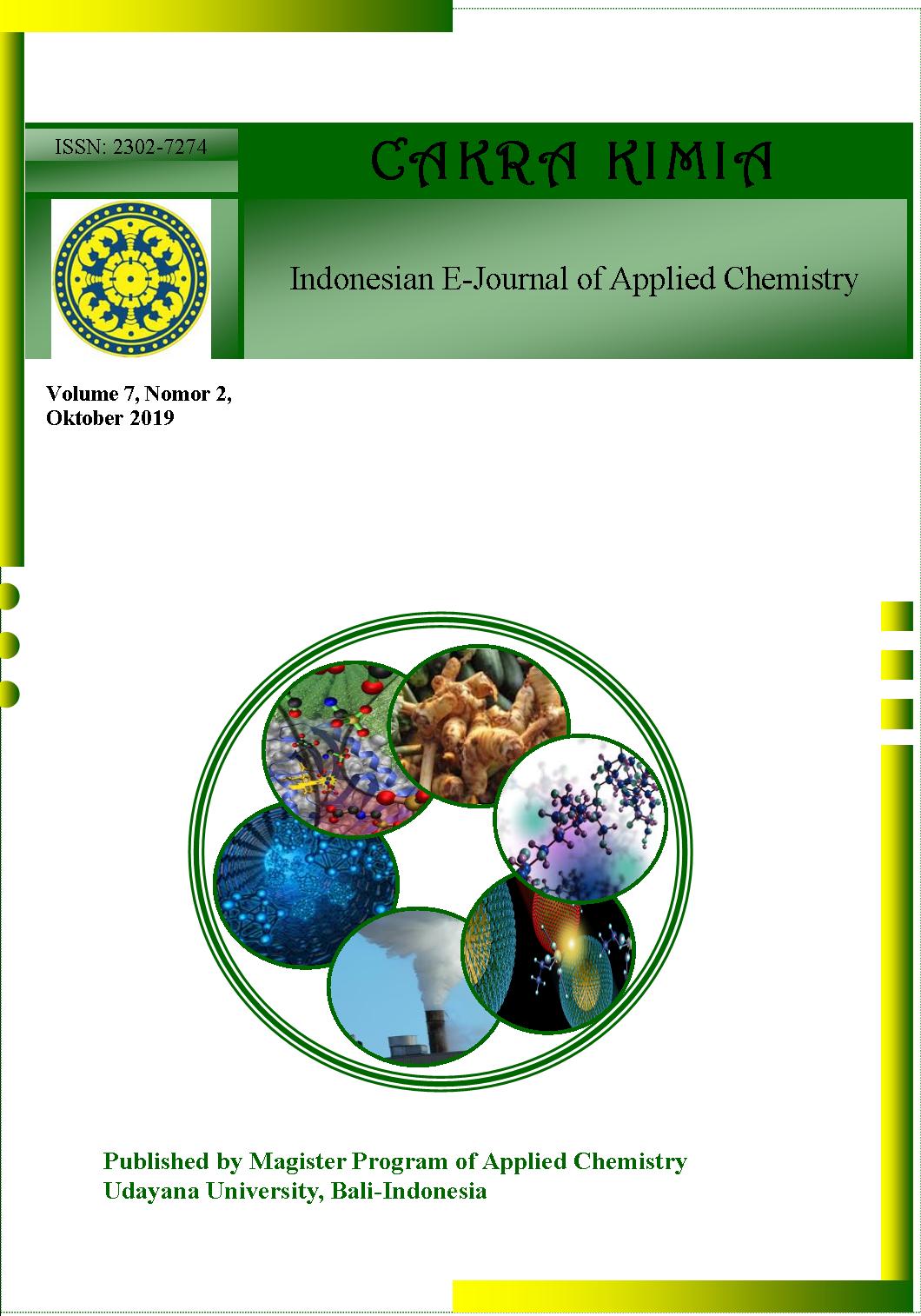POTENSI ANTIMAKAN EKSTRAK DAUN TENGGULUN (Protium javanicum Burm. F.) PADA ULAT KUBIS (Plutella xylostella)
Abstract
ABSTRAK: Daun tenggulun (Protium javanicum Burm. F.) memiliki aktivitas antimakan terhadap larva Epilachna sparsa dan berpotensi untuk dikembangkan sebagai pestisida nabati pada hama target spesifik yaitu ulat kubis (Plutella xylostella). Penelitian ini bertujuan untuk menentukan komponen senyawa yang terkandung dalam ekstrak aktif antimakan daun tenggulun terhadap ulat kubis. Hasil ekstraksi 1000 g serbuk kering daun tenggulun dengan methanol, n heksana dan etil asetat berturut-turut menghasilkan 7,2535 g ekstrak kental n-heksana , 5,5680 g ekstrak kental etil asetat, dan 20,1852 g ekstrak air. Hasil uji aktivitas antimakan menunjukkan etil setat mempunyai aktivitas terbesar ( 84,24 % pada konsentrasi 0,1%). Pemurnian ekstrak aktif etil asetat dengan kromatografi kolom ( silika gel dan fase gerak etil asetat-n-heksana (1:1)) menghasilkan tiga fraksi, dan fraksi B menunjukkan aktivitas antimakan paling tinggi (87,26% pada konsentrasi 100 ppm). Hasil analisis fraksi B dengan GC-MS menghasilkan 77 senyawa, enam diantaranya yaitu senyawa dengan Rt: 22,11 (Mr 170), 23,65’ (Mr 168), 24,6’ (Mr 220), 27,64 (Mr. 260), 31,74’ (Mr. 204), dan 32,8’ (Mr 222) teridentifikasi melalui pendekatan database NIST dan WILET 229 diduga berturut-turut adalah senyawa: linalol oksida, S(+)-5-(1-hidroksi-1-metil)-2-metil-2-sikloheksenon, 2,6-di-t-butil 2,5-sikoheksadiena 1,4-dion, karyopillen, 2-sikloheksen-1-on-4-hidroksi-3,5,6-trimetil-4-(3-oxo-butenil), dan Etil- Oktadekanoat.
Kata kunci: Protium javanicum Burm. F., tenggulun, antimakan, Plutella xylostella
ABSTRACT: Tenggulun leaves ((Protium javanicum Burm. F.) has antifeeding activity on Epilachna sparsa larvae and potential to be developed as pesticide on specific target such as cabbage caterpillar (Plutella xylostella). The purpose of this research is to determine chemical compounds containing on the active extracts of the leaves. The extraction process was conducted by maceration of 1000 grams the leaves with methanol followed by partition with n-hexane, ethyl acetate, and water resutling viscous extracts of 7.2535 g, 5.5680 g, and 20.1852 g respectively. Antifeeding test showed that ethyl acetate extract has the highest activity as antifeeding which is 84.24% with concentration of 0.1 %. Purification process of the ethyl acetate active extract was conducted by coloum chromatography using silica gel and mobile phase of the mixture of ethyl acetate and n-hexane (1 : 1) resulting three fraction where the B fraction showing the highest antifeeding activity which 87.26 % using solution of 100 ppm. Further, analysis the B fraction with GC-MS showed 77 chemical compounds where 6 of them identified by NIST and WILET 229 databases were confirmed as linanol oxide, S(+)5-(1-hydroxy-1-methyl)-2-methyl-2-cyclohexanone, 2,6-di-t-buthyl 2,5-cyclohexadiene 1,4-dion, caryopillen, 2-cyclohexen-1-on-4-hydroxy-3,5,6-trimethyl-4-(3-oxo-buthenyl), and ethyl octadecanoate.
Downloads
References
[2] Sembel, D. T., 2010, Pengendalian Hayati Hama-hama Serangga Tropis dan Gulma, Andi Offset, Yogyakarta
[3] Leatemia, J.A. and Murray, B.I., 2004, Toxicity and Antifeedant Activity of Crude Seed Extract of Annona Squamosa Againts Lepidoptera Pest and Natural Enemies, International Journal of Tropical Insect Science, 24: p.150-158
[4] Ling, B., Guo-cai, W., Ji, Y., Mao-xin, Z., and Guang-wen, L., 2008, Antifeedant Activity and Active Ingredients Againts Plutella xylostella from Momordica charantia Leaves, Agricultural Science in China, 7(12):p. 1466-1473
[5] Rudiger, A. L., Siani, A. C., and Junior, V. F., 2007, The Chemistry and Pharmacology of The South American Genus Proteum Burn. F. (Burseraceae), Pharmacogn Rev. 1 : 93 - 1046.
[6] Setianingsih, N. L. P., Suirta, I W. dan Puspawati, N. M., 2013, Uji Toksisitas Minyak Atsiri Daun Tenggulun (Protium javanicum Burm. F.) dengan Metode Brine Shrimp Lethality Test (BSLT), Jurnal Kimia 7 (2) : 133-140
[7] Sukmajaya, A. P. I G. P., N. M. Puspawati, dan A. A. Bawa Putra, 2012, Analisis Kandungan Minyak Atsiri Daun Tenggulun (Protium javanicum Burm. F.) dengan Metode Kromatografi Gas-Spektroskopi Massa, Jurnal Kimia, 6 (2) : 155-162
[8] Utami, G. A. P., Santi, S. R., Dan Puspawati, N. M., 2014, Minyak Atsiri Daun Tenggulun (Protium javanicum Burm.F.) sebagai Repelan Nyamuk Demam Berdarah (Aedes Aegypti), Jurnal Kimia 8 (1) : 70-76
[9] Mandana, M. G. A., Puspawati, N. M., dan Santi, S. R., 2013 Identifikasi Golongan Senyawa Aktif Antimakan dari Daun Tenggulun (Protium Javanicum Burm. F.) terhadap Larva Epilachna Sparsa, Jurnal Kimia 7 (1) : 39-48
[10] Kubo, I., Taniguchi, M., Chapya, A., and Tsujimoto, K., 1980, An Insect Antifeedant and Antimicrobial Agent from Plumbago caponensis, Journal of Medicinal plant research, Suplement, 185-187.
[11] Mikolajczak, K. L. and Weisleder, D., 1998, A Limonoid Antifeedant from Seed of Carapa procera, J. Nat Prod., 51 (3) : 606- 610
[12] Van Beek, T.A., and de Groot, A., 1986, Terpenoid antifeedants. part I. an overview of terpenoid antifeedants of natural origin. Rec. Trav. Chim. Pays-Bas, 105: 12
[13] Nawrot, J., Bloszyk, E., and Harmatha, J., 1986, Action of antifeedants of plant origin on beetles infesting stored products. Acta Ent Bohemoslov, 83: 327-335
[14] Wieczorek, M., 1996, The effects of plant extracts on the cabbage butterfly, Pieris brassicae (Lepidoptera ), Polish Journal of Entomology, 65: 93-99
[15] Hudayya, Abdi dan Jayanti, H., 2012, Pengelompokkan Pestisida Berdasarkan Cara Kerjanya (Mode of Action), Yayasan Bina Tani Sejahtera, Bandung
16. Mordue (Luntz), A.j., and Nisbet, A.J., 2000. Azadiractin from The Neem Tree Azadirachta indica: its Action Against Insect, An. Soc. Entomol, 29(4): 615-632



 Petunjuk Penulisan
Petunjuk Penulisan
